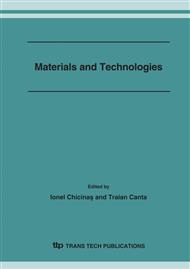p.75
p.79
p.83
p.87
p.91
p.95
p.99
p.103
p.107
Devices for Dry Separation of the Spherical Particles from those Having a Non Spherical Shape from a Metallic Powder
Abstract:
The paper describes the working principles for six types of separation devices mentioned in the literature, as well as two original types of separation devices devised by the author. In fact the functionality of each device presented in the paper is based on the difference between the friction coefficients – sliding friction for non-spherical particles and rolling friction for spherical ones, respectively. Due to this peculiarity, the two types of particles move along different trajectories, thus becoming separable. The paper also discusses the limit conditions ensuring the functionality of each separation device.
Info:
Periodical:
Pages:
91-94
Citation:
Online since:
October 2007
Authors:
Price:
Сopyright:
© 2007 Trans Tech Publications Ltd. All Rights Reserved
Share:
Citation:


